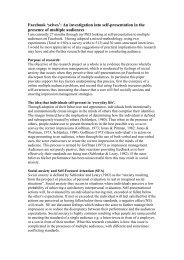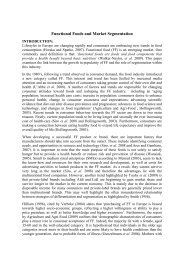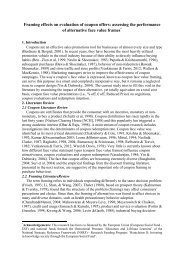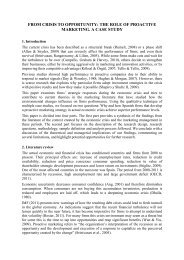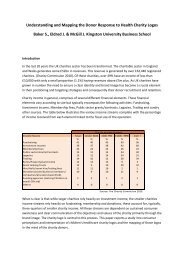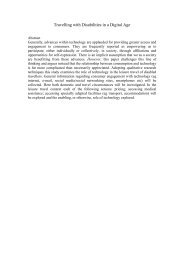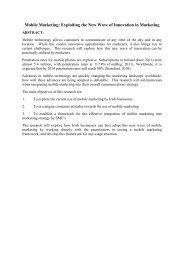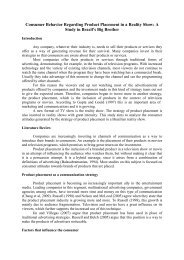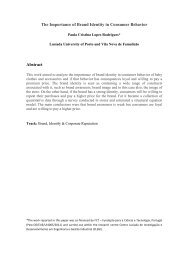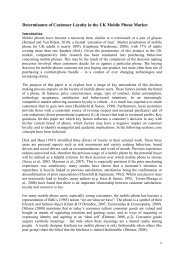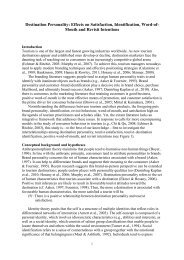EXQ: A Multiple-Item Scale for Assessing Customer Experience In ...
EXQ: A Multiple-Item Scale for Assessing Customer Experience In ...
EXQ: A Multiple-Item Scale for Assessing Customer Experience In ...
You also want an ePaper? Increase the reach of your titles
YUMPU automatically turns print PDFs into web optimized ePapers that Google loves.
<br />
loyalty (Badgett, Boyce and Kleinberger, 2007). A corresponding scale needs to be<br />
developed to evaluate the service experience from the customer’s point of view (Verhoef et<br />
al., 2009). To develop the new measure, it is recognized that “scale [development] must go<br />
hand-in-hand with conceptual development of the construct [service experience] itself”<br />
(Brakus et al., 2009, p. 52). There<strong>for</strong>e the measure should be based on a broader and more<br />
comprehensive conceptualization (Verhoef et al., 2009) that links the service experience to<br />
purchasing behaviour. This conceptual model of service experience aims to refine existing<br />
conceptual models <strong>for</strong> customer experience which have been proposed both in conceptual<br />
studies (Verhoef et al., 2009) and in studies which elicit the supplier’s perception rather than<br />
the customer’s (Payne et al., 2008; Voss et al., 2008). We recapitulate that service experience<br />
is an evolving concept. The emerging service experience construct is far broader than the<br />
limited functional service encounter suggested by current measures. It includes pre and post<br />
service encounter experiences, addresses emotional as well as functional dimensions of<br />
quality and includes the customer’s social context. It includes an assessment of value-in-use,<br />
is <strong>for</strong>med over multiple channels and varies with context (Lemke et al., 2010). Building on<br />
this and the previously cited definitions, and the context of our research, we define service<br />
experience as the customer’s cognitive and affective assessment of all direct and indirect<br />
encounters with the firm relating to their behavioural loyalty as defined by Oliver (1997).<br />
This article describes the development and validation of a multiple-item scale <strong>for</strong><br />
service experience (<strong>EXQ</strong>) and provides (a) a sought after conceptualization that captures the<br />
domains of the construct, (b) a measure from the customers’ point of view, (c) a validation of<br />
the psychometric properties of the scale and (d) it demonstrates the effects of our empirically<br />
derived conceptualization with respect to important customer outcomes: satisfaction, loyalty<br />
and word-of-mouth. Drawing from the literature, we conduct a qualitative study that<br />
generates attributes of service experience. The proceeding section describes the purification<br />
and validation of a scale and its psychometric properties. The article then validates the scale<br />
to generate an empirically founded definition of service experience (<strong>EXQ</strong>). The penultimate<br />
section explores the nature and degree of <strong>EXQ</strong>’s impact on customers’ satisfaction, loyalty<br />
and word-of-mouth. The final section discusses the findings of the study and its managerial<br />
implications<br />
Definition and Domain of <strong>EXQ</strong><br />
To incorporate the wide range of possible assessment of service experience criteria arising<br />
from the literature, we use a framework based on the means-end-chain approach<br />
(Parasuraman et al., 2005). Our study presents a validated multi-item scale based on the<br />
underlying construct of service experience that extends previous research on service<br />
experience and service quality measures. The measure is called the service experience scale:<br />
‘<strong>EXQ</strong>’. The research determines its dimensions by analysing that which customers describe<br />
as the triggers of their purchasing and re-purchasing behaviour. The methodology follows<br />
Churchill’s (1979) scale development paradigm. As suggested by the literature, and other<br />
scale-developing studies (Walsh and Beatty, 2007), the scale will be developed in four stages:<br />
scale generation, initial purification, refinement and validation (<strong>for</strong> a more detailed<br />
description of the procedure see Appendix A).<br />
Stage 1 articulates the meaning and domain of service experience based on insights<br />
from the literature and a comprehensive qualitative study. It results in a preliminary scale<br />
containing 37 items that represent five dimensions. Stage 2 describes the administration of<br />
the scale to a representative sample of repeat mortgage purchasers of a UK bank from 175<br />
completed questionnaires. Using exploratory factor analysis, the scale is purified to 19 items<br />
2



